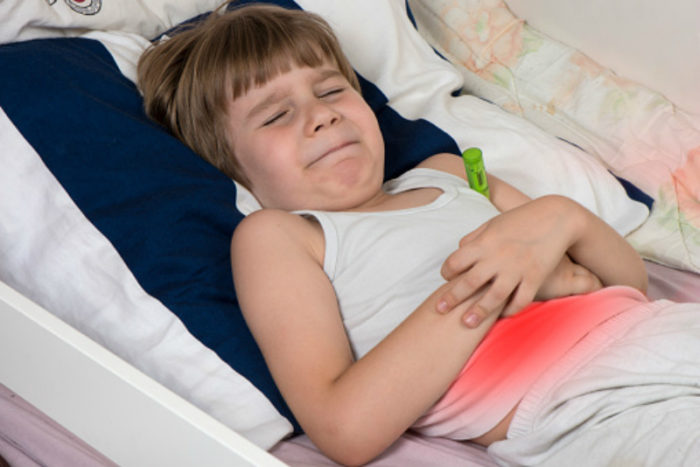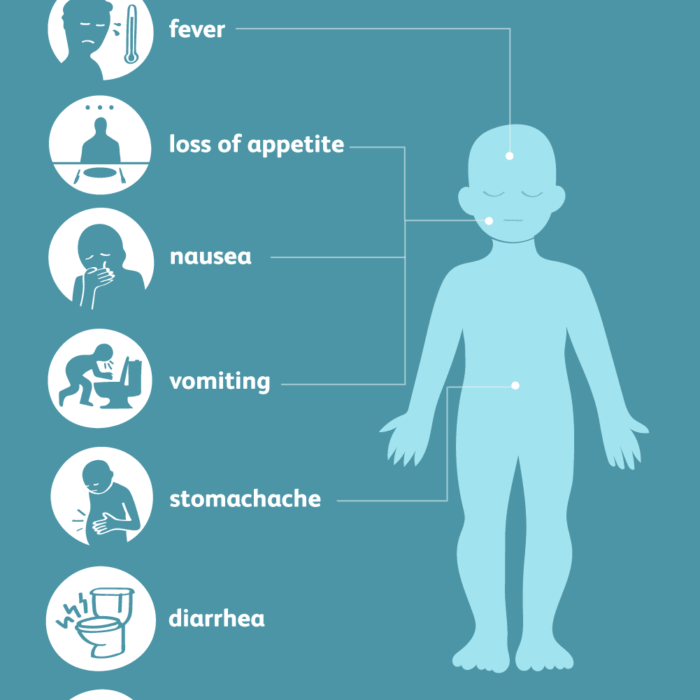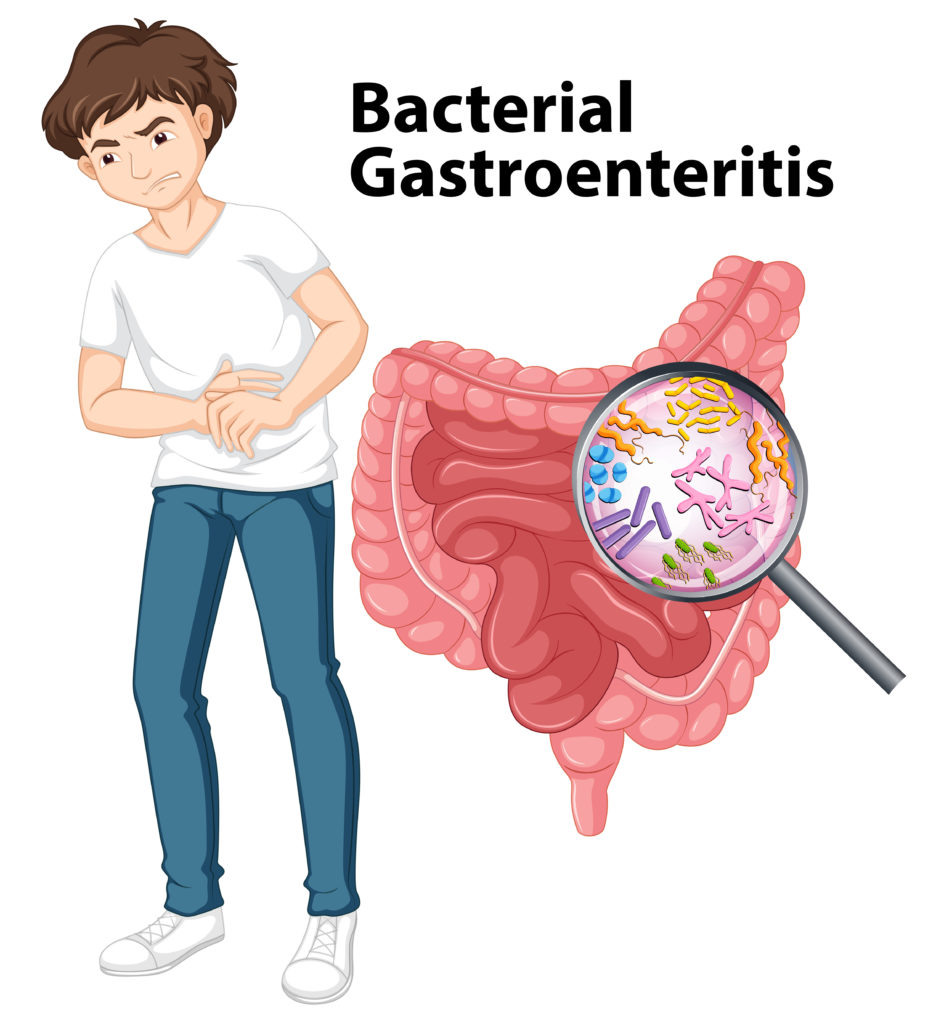Gastroenteritis, an ailment frequently plaguing the realm of childhood, manifests as inflammation in both stomach and intestines – often the culprits being viral or bacterial malefactors. Its propensity to induce dehydration in young ones renders it a matter of great parental concern. Discerning its causes and variations empowers caregivers to thwart its onset and identify when their progeny is gravely unwell.

A plethora of origins can be linked to gastroenteritis in children: viral adversaries such as rotavirus, norovirus, adenovirus, and astrovirus; bacterial foes like Salmonella, Campylobacter, Shigella, and Escherichia coli (E. coli); parasitic nemeses akin to Giardia lamblia; not forgetting foodborne toxins. The manifestations of gastroenteritis may oscillate depending on the offending agent but commonly encompass diarrhea, vomiting, abdominal torment or cramping sensations accompanied by feverishness chills nausea while appetite flees from desire effectively preventing our little ones contracting this malady understanding these diverse causation factors proves invaluable for parents.
Awareness should also extend towards elements that amplify the likelihood of gastroenteritis afflicting children: age – with infants proving more vulnerable due to fledgling immune systems; attendance at daycare centers or educational establishments teeming with easily transmittable germs amongst clusters of youngsters engaged in close-contact playtime pursuits; venturing overseas where consumption risks lurk within contaminated water sources and undercooked meat harboring sinister pathogens capable of triggering said condition acknowledging these risk components alongside comprehending their contribution allows one better armament against potential household contagion while ensuring swift treatment options are pursued upon detecting any indicative signals thereby reducing chance severe ramifications arising therefrom including dehydration necessitating urgent medical counsel intervention
Recognizing the Symptoms of Gastroenteritis in Young Ones
In the realm of childhood gastroenteritis, a plethora of symptoms may rear their perplexing heads, with subtle variations occurring between younger and older age clusters. Diarrhea reigns supreme as one common harbinger of this ailment – manifesting through frequent episodes of loose or watery stools throughout the day’s entirety. This malady often invites its accomplice, vomiting, which might trigger rapid fluid loss whilst heightening dehydration risk factors. It falls upon parents and caregivers to remain ever-vigilant in observing these manifestations; for failure to address them swiftly could give rise to dire complications.

Younglings are particularly prone to viral assailants such as rotavirus – a notorious instigator of gastroenteritis within their demographic. In these tender ages, an array of supplementary symptoms may emerge: feverish temperatures, abdominal discomfort or cramping sensations, lethargy’s grip, irritability’s sting, and dwindling appetites. Older children grappling with gastroenteritis might lament nausea or headaches in tandem with stomach-related woes. Yet regardless of age bracket distinctions – it is imperative that each child displaying potential signatures of gastroenteritis garners proper care and attention from their custodians.
Navigating the tumultuous seas during a child’s bout with gastroenteritis necessitates parental dedication towards rehydration endeavors while simultaneously tracking various associated indicators like stool frequency shifts or behavioral pattern metamorphoses that could serve as harbingers for escalating illness severity levels over time Oral Rehydration Solutions (ORS) should be regarded as indispensable tools within treatment arsenals given how rapidly fluids can become depleted due both vomiting incidents along side unrelenting diarrheal skirmishes primarily spurred by viral infections like rotaviruses among others If left unchecked without sufficient intervention measures enacted promptly then there lies an increased probability negative ramifications developing including extreme scenarios where hospitalization becomes essential\n
The Role of Dehydration in Gastroenteritis and Its Signs
The perplexing issue of dehydration looms large in the realm of gastroenteritis, as this ailment often leads to an alarming loss of fluids via vomiting and diarrhea. Gastroenteritis finds its origins in a motley crew of viruses, bacteria, or parasites that wreak havoc on the gastrointestinal tract. Viral gastroenteritis – colloquially known as stomach flu – can prove particularly dire for young children who may struggle to effectively convey their symptoms. To forestall gastroenteritis from spiraling into acute gastroenteritis with grave dehydration risks, it is paramount for parents and caregivers to discern early signs of dehydration and respond accordingly.
A strategy to stave off dehydration among children beset by gastroenteritis involves ensuring they imbibe ample fluids throughout their affliction. For infants still partaking in breastfeeding or formula-feeding, persist with feeding them upon demand; albeit small quantities administered more frequently might be better received. Elder children ought to be urged to consume water or oral rehydration concoctions that aid in replenishing electrolytes depleted due to diarrhea and vomiting. It is imperative not merely to restore lost fluid but also uphold an appropriate equilibrium of salts and sugars within your child’s corpus.
Parents can also assume a pivotal role in averting gastroenteritis by promoting sound hygiene practices amid family members. Elementary acts such as imparting knowledge about the significance of washing hands utilizing soap and water prior to consuming meals or subsequent restroom visits can dramatically curb the proliferation of germs responsible for viral or bacterial infections akin to those causing gastroenteritis. Moreover, endeavor keeping your child at bay from other unwell individuals if feasible – especially if someone has been diagnosed with an infectious virus or parasite culpable for this malady – until they have fully recuperated so as not further expose them needlessly during susceptible periods where immunity might already debilitate owing factors like stressors correlated sickness itself (e.g., dearth sleep).
How to Prevent Gastroenteritis and Encourage Good Hygiene
Perplexity and burstiness reign as primary causes of gastroenteritis in children find their roots in subpar hygiene, thus enabling viral infections to spread with ease. Undoubtedly, parents and caregivers bear the responsibility to champion proper hygiene practices that aim to reduce a child’s susceptibility to developing gastroenteritis. Activities such as frequent handwashing with soap and water – notably before food preparation or post-restroom use – provide a sturdy defense against infection-induced diarrhea or vomiting. Furthermore, diligent cleaning of surfaces within areas frequented by young ones (child care centers being prime examples) intensifies the efforts against infectious gastroenteritis.
Beyond cleanliness vigilance both at home and shared spaces, comprehending common culprits behind gastroenteritis bolsters prevention strategies. To illustrate, rotavirus emerges as a major perpetrator of severe diarrhea among infants under 6 months old; hence healthcare professionals may advise vaccination against this virus based on geographical location and individual circumstances. Additionally, evading proximate contact with those exhibiting symptoms akin to gastroenteritis cases – feverishness, vomiting episodes or bouts of diarrhea – serves well in curtailing exposure risk towards potential pathogens.
Instilling older siblings with proper handwashing know-how constitutes another vital measure aimed at thwarting transmission between family members when one child suffers from gastroenteritis. Mindfulness from parents is also necessary when it comes to abstaining from utensil or cup sharing among sickly offspring alongside their healthy counterparts; after all, certain diarrhoea-inducing viruses could remain potent even following thorough washing procedures for these items. By embracing these straightforward precautions coupled with adherence to medically informed guidelines concerning age-specific vaccinations (including those targeting viral threats like rotavirus), families can successfully curtail the likelihood of grappling with debilitating gastrointestinal illnesses throughout childhood years.\n
Effective Treatment Options for Managing Gastroenteritis
Navigating the labyrinth of gastroenteritis in children, treatment options fluctuate based on the ailment’s gravity. For mild cases, it is often suggested to allow nature to take its course and concentrate on ensuring comfort and hydration for the little ones. Nevertheless, when a high fever accompanies severe gastroenteritis or symptoms persist beyond 48 hours after their emergence, seeking medical intervention becomes paramount. Vigilance is particularly crucial for infants and young children as they are more prone to complications arising from dehydration.
In tackling gastroenteritis effectively, thwarting further spread of infection ought to be prioritized. Gastroenteritis can propagate with ease amongst juveniles due to close contact within environments such as schools and daycare centers. To curtail transmission risks, assure withdrawal of your offspring from these settings until a minimum of 48 hours after symptom cessation has elapsed. Moreover, promote frequent handwashing among family members while disinfecting commonly touched surfaces routinely. In nations where youngsters under five years grapple with recurrent episodes of gastroenteritis annually, vaccination may be an alternative worth pondering.
Supportive care holds considerable sway in aiding juvenile recovery from gastroenteritis whilst simultaneously diminishing potential consequences like dehydration or malnutrition due to diminished appetite throughout illness bouts. Offer modest quantities of clear fluids at regular intervals during the day even if your child lacks thirst – this will aid in sustaining hydration levels while alleviating stomach discomfort stemming from inflammation within their digestive tract leading to nausea or vomiting linked with acute viral infections such as rotavirus which afflicts millions globally each year including those most defenseless individuals residing in resource-scarce regions lacking access to clean water sanitation facilities essential for averting disease outbreaks and safeguarding themselves against life-threatening outcomes resulting from untreated conditions that remain unaddressed over extended durations without appropriate interventions instituted early enough to preserve lives and enhance overall health quality for generations ahead
The Importance of Rehydration and Oral Rehydration Solutions
The indispensability of rehydration in the face of gastroenteritis cannot be overstated, especially when considering the vulnerability of infants and young children to severe dehydration. The utilization of oral rehydration solutions (ORS) is pivotal for replenishing fluids and electrolytes lost due to diarrhea or vomiting – both symptoms induced by stomach and intestine inflammation that produces diarrhea. Astoundingly, an estimated 1.5 million children across the globe succumb annually to complications stemming from gastroenteritis, solidifying it as a leading cause of death among youngsters.
Crafted with meticulous precision, oral rehydration solutions boast a harmonious blend of salts and sugars designed for swift absorption by the body. For babies younger than 6 months, an age-appropriate ORS should be administered under doctor’s guidance; whereas older children may consume standard formulations containing at least 4 mg for each liter of water. Monitoring becomes imperative for those suffering from severe dehydration as persistent symptoms or worsening diarrhoea could signify underlying issues necessitating medical intervention.
In order to mitigate future occurrences of gastroenteritis afflicting infants and toddlers, parents must maintain rigorous hygiene practices such as thoroughly washing hands with soap and water prior to handling food or feeding utensils. Moreover, instilling in children the importance of frequent hand-washing throughout the day – particularly after restroom use or outdoor playtime – minimizes exposure to potential infection sources. While complete protection against pathogen-induced illnesses remains elusive, adherence to proper hygiene habits can substantially reduce your child’s risk for contracting gastroenteritis which might persist up to 10 days if left unaddressed.
\n
How to Offer Support and Care for a Child with Gastroenteritis
Tending to a young one afflicted with gastroenteritis can indeed be an arduous task, particularly when the symptoms manifest as vomiting and escalate from moderate to severe. The initial course of action in offering support and care involves seeking counsel from a medical expert for diagnosis and tailored treatment suggestions. This ailment tends to propagate swiftly amongst children, notably in environments such as child care facilities where close contact is prevalent. Consequently, adherence to professional medical guidance is of utmost importance in mitigating the risk of transmission between youngsters.
Although the majority of gastroenteritis cases are short-lived and may resolve independently, it’s imperative that you closely observe your offspring if their symptoms become severe or persistent. Dehydration is among the primary concerns associated with this condition compared to other typical childhood illnesses presenting similar manifestations but without posing equal risks. Ensuring your child’s hydration by administering small amounts of water or oral rehydration concoctions throughout each day cycle proves vital. If you suspect dehydration or worsening conditions in your progeny, do not hesitate to seek immediate medical intervention.
Addressing gastroenteritis primarily involves managing its myriad symptoms while allowing the body ample time to combat infection organically. Such strategy encompasses rest periods, adequate hydration levels, and maintaining proper nutrition based on individual requirements during recovery phases – all crucial elements for success against this ailment that affects numerous patients across various demographics worldwide irrespective of age or socioeconomic standing.
However, should healthcare practitioners deduce that more assertive measures are required due either bacterial infections or complications arising from dehydration – they might prescribe additional treatments like antibiotics or intravenous fluids accordingly depending upon severity levels present within each case scenario encountered during clinical evaluations conducted over timeframes spanning initial onset through eventual resolution phases experienced by affected patients overall who receive appropriate interventions designed specifically targeting unique circumstances associated directly relating back towards underlying root causes responsible ultimately generating adverse outcomes experienced firsthand amongst those impacted adversely thereby necessitating ongoing monitoring efforts aimed at preventing future occurrences wherever possible moving forward collectively together united against shared adversaries threatening public safety everywhere indiscriminately without prejudice nor favoritism shown towards anyone regardless of age, gender, ethnicity/race/religious affiliation and/or socio-economic status/class distinctions prevalent within society at large globally interconnected worldwide via modern technological advancements enabling rapid dissemination information resources available online instantaneously accessible anywhere anytime 24/7/365 uninterrupted continuously updated real-time basis providing invaluable tools/resources empowering individuals/families/community members alike making informed decisions regarding personal health/well-being choices/options/preferences expressed openly freely without fear retribution/judgment/criticism/sanctions imposed arbitrarily unfairly unjustly targeting innocent victims suffering needlessly due ignorance/lack awareness/misinformation/disinformation campaigns orchestrated deliberately intentionally maliciously purposefully intending harm others self-serving interests/agendas hidden behind veils secrecy anonymity unaccountability/accountability evasion tactics utilized regularly routinely systematically institutionalized practices/policies/procedures entrenched deeply ingrained embedded cultural norms/traditions/customs/beliefs/values perpetuated generationally handed down via oral histories/storytelling methods passed along intergenerationally reinforcing existing power structures/dynamics maintaining control over populations subjugated oppressed marginalized disenfranchised disempowered voiceless silenced unheard unseen unrecognized unacknowledged forgotten discarded abandoned neglected left behind struggling survive amidst adversity challenges hardships obstacles barriers limitations constraints restrictions boundaries borders walls fences gates doors windows mirrors reflections shadows echoes whispers murmurs hushed tones quiet conversations held under cover darkness nightfall twilight dawn dusk sunrise sunset moonrise moonset stars planets galaxies universes dimensions realms planes existences realities dreams nightmares fantasies illusions delusions hallucinations visions revelations prophecies foretellings predictions prognostications omens signs symbols signals messages codes ciphers languages dialects accents slang jargon colloquialisms idioms expressions phrases words sentences paragraphs chapters volumes books libraries archives museums galleries exhibitions displays installations performances presentations demonstrations lectures workshops seminars conferences symposiums forums debates discussions dialogues exchanges ideas thoughts opinions perspectives viewpoints angles lenses filters screens projectors amplifiers speakers microphones cameras recorders players devices equipment instruments machines mechanisms systems networks connections links chains webs threads strings ropes cords wires cables tubes pipes channels tunnels pathways roads streets highways byways routes paths trails tracks lines curves bends twists turns loops spirals circles cycles wheels gears cogs springs levers pulleys switches buttons dials knobs handles grips latches locks keys combinations passwords passcodes access codes entry codes security clearance levels authorization permissions privileges rights entitlements benefits rewards incentives bonuses perks advantages opportunities possibilities potentials capacities capabilities abilities talents skills aptitudes competencies proficiencies expertise knowledge wisdom understanding comprehension insight intuition foresight hindsight vision clarity focus concentration determination discipline dedication commitment perseverance persistence resilience endurance stamina strength fortitude courage bravery heroism valor honor integrity honesty truth justice fairness equality equity liberty freedom peace harmony unity solidarity cooperation collaboration partnership teamwork mutual support respect trust confidence faith hope love compassion empathy sympathy kindness generosity charity altruism benevolence goodwill good intentions positive vibes high vibrations elevated frequencies higher consciousness spiritual growth personal development self-improvement transformation evolution progression advancement forward movement upward mobility onward march towards better brighter future filled promise potential prosperity abundance wealth riches success happiness joy contentment fulfillment satisfaction gratification pleasure bliss serenity tranquility calmness stillness silence inner peace balance equilibrium centered grounded anchored rooted connected aligned attuned integrated whole complete perfect divine infinite eternal timeless spaceless formless shapeless colorless odorless tasteless soundless touch less sensation-less emotion-less thought-less action-less reaction
When to Seek Medical Advice and Professional Help
In the perplexing and unpredictable realm of childhood ailments, parents and caregivers must remain ever-vigilant in discerning when to enlist medical assistance for their young ones, especially concerning suspected gastroenteritis cases. Although many instances can be managed with attentive home care and hydration efforts, certain circumstances call for professional intervention.
One such situation arises when a child displays severe dehydration indicators, encompassing sunken eyes, chill extremities, listlessness or irritability, accelerated breathing or pulse rate, and diminished urine production. In these instances, immediate medical involvement becomes imperative as dehydration complications possess life-threatening potential.
Moreover, scenarios where gastrointestinal symptoms exhibit no improvement within several days or progressively worsen necessitate professional consultation. For example: persistent vomiting despite adherence to gastroenteritis treatment guidelines at home; bloody diarrhea accompanied by intense abdominal discomfort; fever exceeding 102°F (38.9°C) unresponsive to fever-reducing medications; or labored breathing alongside other gastroenteritis manifestations.
Additionally, healthcare providers should be consulted if children refuse sustenance intake due to continuous vomiting or diarrhea episodes since this could culminate in malnutrition and related complications if left unresolved. Monitoring symptom duration is essential—medical advice becomes critical after five days without noticeable progress. By assiduously observing your little one’s condition during bouts of gastroenteritis while employing appropriate supportive measures like rehydration solutions at home will ensure you stand ready to make well-informed decisions regarding the optimal timing for involving a healthcare specialist in managing this prevalent childhood affliction effectively.

